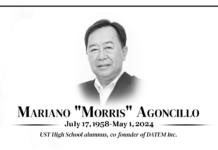PICTURE this: Students packed at corridors taking up their major subjects. Some end up in distant stairways for their lessons as classes are held outside classrooms.
No, this is not scenario from a typical public school, but from the UST Conservatory of Music, one of the two only Centers of Excellence (COE) in music education in the country as declared by the Commission in Higher Education (CHED).
Situated at the Albertus Magnus Building, the Conservatory is housed with the College of Education, Institute of Tourism and Hospitality Management, and Education High School. Their classrooms and studios are placed in different floors: a couple of studios at the first floor, a series of other studios at the third, and most of the classrooms at the fifth.
With over 600 students majoring in eight musical programs, the Conservatory’s failities are hardly sufficient for its growing population. It has two recital halls that can sit 150 persons each at the fifth floor, 11 studios at the third floor where the students have their one-on-one sessions with their professors an hour a week, and lecture rooms for their minor subjects that are scattered throughout the building. Even then, the students would occasionally transfer to the neighboring Faculty of Engineering Bldg., to take up classes for minor subjects such as Literature due to the scarcity of rooms.
Despite the lack of studios for its students, the Conservatory offers extension classes for non-Thomasians on weekends. This adds to the demand for more studios.
The old school
The Conservatory started in July 1945, with six classes of piano, voice culture and violin lessons held at the back of the stage of the UST Gymnasium. In 1948, the Conservatory moved to a building between the UST Hospital and the Engineering Bldg., known as the “concert hut.”
Music students expressed surprise when shown photos of the old Conservatory.
“We did not recognize a picture (of it) that showed the Conservatory with a 500-seat auditorium,” Music Student Council president Nomer Madridemo said. “It was posh and elegant, with curtains and seats that had ‘UST’ labeled at the back,”
It was during Director Sergio Esmilla, Jr.’s term in 1964 that the “concert hut” was demolished. The Albertus Magnus Bldg. was built in its place. The Conservatory was relocated to the fifth floor of the new building.
Two in one
Now, due to lack of practice rooms, it is an ordinary sight for Music students to practice along corridors, and to assign a whole orchestra or a band in the hallways, clogging up the space meant for passersby.
“The studios are also used as practice rooms, and vice-versa,” Faculty Secretary Antonio Africa said. “From 9 a.m. to 12 p.m., these function as studios; from 12 p.m. to 1 p.m. they turn to practice rooms; from 1 to 5 p.m. they turn to studios again; then from 5 onwards, if there are no more teachers, they become practice rooms again,” he said.
Ideally, a studio should be different from a practice room to secure the proper tuning of the instruments. “You cannot just have anyone meddle with a piano or any other instrument in a studio because of its pre-set tuning that the students may need to alter when practicing,” Madridemo said.
Also, due to the lack of practice rooms, students would rather linger along the corridors, clutching their instruments with makeshift stands holding their music sheets, instead of waiting for a practice room to become available.
“We can’t stop the students from practicing; in fact, we are encouraging them to practice for two to three hours a day,” Africa said.
From 5 p.m. onwards, music students also lack the opportunity to use the studios because the keeper of the keys would be nowhere.
“It is difficult most especially for piano majors to practice because studios are usually locked after the 9 a.m. to 5 p.m. sessions. We have to tell them (key keepers) that we need a few more hours to practice in the studios, but we sometimes fail to do so,” Madridemo said.
With the rapid evolution of music, the Conservatory also needs more advanced media equipment. But there are practically none.
“Sadly, we have only one CD player for the whole Conservatory,” Africa said. “We have amplifiers and multi-purpose public announcement systems but these are all limited.”
“Music today is applied in a variety of mediums, how can we compete globally without the needed technological advances?” Madridemo said.
Furthermore, with subjects like Music Technology, which Africa teaches, a sufficient amount of computers is a must. But the lone media room of the Conservatory has eight sets of computers, only six of which have been restored.
“We cannot start arranging these computers in the media room due to the lack of space,” he said
Moreover, Madridemo suggests that all classrooms should have LCD projectors and media players, since music education entails a lot of performances as well as listening exercises.
Too many scholars?
Since 200 out of the 600 Music students are scholars, a common misconception about the Conservatory is that it is financially troubled. Students comprising orchestras and ensembles in the Conservatory are scholars.
“I don’t think it is the reason why we lack funding because the University would not allow us to submit as many scholars as we would like to, “ Africa said. “And not all are 100 per cent tuition-free.”
Music Dean Raul Sunico explained that most music schools worldwide are not income-generating, like the Conservatory. There is a large outplay of costs for instruments and productions than what the Conservatory earns.
Africa said that they are still working on a master plan to address the problems of the Conservatory.
“I am open to any plans. But since Dean Sunico has not yet proposed any plan, any changes may have to wait,” UST Rector Fr. Ernesto Arceo, O.P., told the Varsitarian.
Sunico and his colleagues are coming up with long-term plans for the Conservatory.
“Hopefully, we can have a permanent home for the Conservatory of Music, but that’s just wishful thinking for now,” Africa said. “I believe we can do with an additional of 10 more studios, our own theater, and an organized set of lecture rooms.”
Both administrators and students agree that it would be better and more comfortable if the facilities for Music students are defined, and not dispersed in three of the five floors of the Albertus Magnus Bldg.
The Conservatory would also like to venture into more advanced method of teaching so that students would better compete globally.
“We hope to offer courses such as Music Therapy and Music Technology in the future. But we could only dream that today, since we don’t have space for our present offered courses,” Africa said.
Dream Academy
Despite all the technical problems, the Conservatory has been reaping numerous national and international awards through its faculty, students, and alumni since its inauguration in 1946. Among its alumni are Benjamin Tupas, Regalado Jose, Fr. Manuel Maramba, Sergio Esmilla Jr., Conching Rosal, Sylvia La Torre, Leticia Liboon, Juanita Javier-Torres, and Fara Lizardo. National Artists in Music Ernani Cuenco and Antonino Buenaventura studied and taught in the Conservatory.
Musical ensembles such as the UST Symphony Orchestra, Symphony Band, and Singers are consistently bringing pride to the University by participating and winning in international competitions. Since 1973, its students have been persistent winners in the National Music Competitions for Young Artists (NAMCYA), in the country.
During the term of Dean Erlinda Fule, the CHED named the Conservatory as a COE in Music alongside the University of the Philippines College of Music.
Africa and Sunico expressed their relief that even with problems that hamper the Conservatory’s performance, it continues to produce quality and globally-competitive students.
“The perseverance, quality mentoring, and pure talent might as well serve as springboards to success for the students,” Madridemo said.









